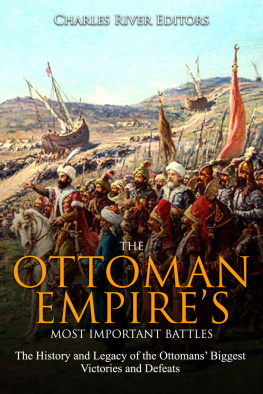Charles River Editors - The Assyrian Empire’s Capitals: The History and Legacy of Nineveh, Assur, and Nimrud
Here you can read online Charles River Editors - The Assyrian Empire’s Capitals: The History and Legacy of Nineveh, Assur, and Nimrud full text of the book (entire story) in english for free. Download pdf and epub, get meaning, cover and reviews about this ebook. year: 2019, publisher: Charles River Editors, genre: History. Description of the work, (preface) as well as reviews are available. Best literature library LitArk.com created for fans of good reading and offers a wide selection of genres:
Romance novel
Science fiction
Adventure
Detective
Science
History
Home and family
Prose
Art
Politics
Computer
Non-fiction
Religion
Business
Children
Humor
Choose a favorite category and find really read worthwhile books. Enjoy immersion in the world of imagination, feel the emotions of the characters or learn something new for yourself, make an fascinating discovery.
- Book:The Assyrian Empire’s Capitals: The History and Legacy of Nineveh, Assur, and Nimrud
- Author:
- Publisher:Charles River Editors
- Genre:
- Year:2019
- Rating:3 / 5
- Favourites:Add to favourites
- Your mark:
- 60
- 1
- 2
- 3
- 4
- 5
The Assyrian Empire’s Capitals: The History and Legacy of Nineveh, Assur, and Nimrud: summary, description and annotation
We offer to read an annotation, description, summary or preface (depends on what the author of the book "The Assyrian Empire’s Capitals: The History and Legacy of Nineveh, Assur, and Nimrud" wrote himself). If you haven't found the necessary information about the book — write in the comments, we will try to find it.
The Assyrian Empire’s Capitals: The History and Legacy of Nineveh, Assur, and Nimrud — read online for free the complete book (whole text) full work
Below is the text of the book, divided by pages. System saving the place of the last page read, allows you to conveniently read the book "The Assyrian Empire’s Capitals: The History and Legacy of Nineveh, Assur, and Nimrud" online for free, without having to search again every time where you left off. Put a bookmark, and you can go to the page where you finished reading at any time.
Font size:
Interval:
Bookmark:
By Charles River Editors

A picture of a lamassu at the Northwest Palace of Ashurnasirpal II in Nimrud

Charles River Editors provides superior editing and original writing services across the digital publishing industry, with the expertise to create digital content for publishers across a vast range of subject matter. In addition to providing original digital content for third party publishers, we also republish civilizations greatest literary works, bringing them to new generations of readers via ebooks.
Sign up here to receive updates about free books as we publish them , and visit Our Kindle Author Page to browse todays free promotions and our most recently published Kindle titles.

Picture of a stele found at Nimrud
I fought daily, without interruption against Taharqa, King of Egypt and Ethiopia, the one accursed by all the great gods. Five times I hit him with the point of my arrows inflicting wounds from which he should not recover, and then I laid siege to Memphis his royal residence, and conquered it in half a day by means of mines, breaches and assault ladders.-Esarhaddon
I captured 46 towns...by consolidating ramps to bring up battering rams, by infantry attacks, mines, breaches and siege engines.-Sennacherib
When scholars study the history of the ancient Near East, several wars that had extremely brutal consequences (at least by modern standards) often stand out. Forced removal of entire populations, sieges that decimated entire cities, and wanton destruction of property were all tactics used by the various peoples of the ancient Near East against each other, but the Assyrians were the first people to make war a science. When the Assyrians are mentioned, images of war and brutality are among the first that come to mind, despite the fact that their culture prospered for nearly 2,000 years.
Like a number of ancient individuals and empires in that region, the negative perception of ancient Assyrian culture was passed down through Biblical accounts, and regardless of the accuracy of the Bibles depiction of certain events, the Assyrians clearly played the role of adversary for the Israelites. Indeed, Assyria (Biblical Shinar) and the Assyrian people played an important role in many books of the Old Testament and are first mentioned in the book of Genesis: And the beginning of his kingdom was Babel and Erech, and Akkad, and Calneh, in the land of Shinar. Out of that land went forth Ashur and built Nineveh and the city Rehoboth and Kallah. (Gen. 10:10-11).
Although the Biblical accounts of the Assyrians are among the most interesting and are often corroborated with other historical sources, the Assyrians were much more than just the enemies of the Israelites and brutal thugs. A historical survey of ancient Assyrian culture reveals that although they were the supreme warriors of their time, they were also excellent merchants, diplomats, and highly literate people who recorded their history and religious rituals and ideology in great detail. The Assyrians, like their other neighbors in Mesopotamia, were literate and developed their own dialect of the Akkadian language that they used to write tens of thousands of documents in the cuneiform script (Kuhrt 2010, 1:84). Furthermore, the Assyrians prospered for so long that their culture is often broken down by historians into the Old, Middle, and Neo Assyrian periods, even though the Assyrians themselves viewed their history as a long succession of rulers from an archaic period until the collapse of the neo-Assyrian Empire in the 7th century BCE. In fact, the current divisions have been made by modern scholars based on linguistic changes, not on political dynasties (van de Mieroop 2007, 179).
An examination of Nineveh demonstrates that in many ways it was the victim of the people who built it. When Nineveh was at its height, they controlled an empire that encompassed Egypt, Anatolia, Mesopotamia, and parts of Iran. Eventually, the Assyrians overextended themselves and their enemies overthrew them and destroyed much of their cities. Nineveh became lost for centuries, only mentioned in fragments by classical Greek historians, but modern archaeological methods were able to bring the lost city back to life in the nineteenth century. Today, through a combination of archaeological reports, classical Greek accounts, and ancient cuneiform inscriptions, the chronology of Nineveh can be reconstructed. An examination reveals that Nineveh played a vital role in the religious and political history of the ancient Near East and despite suffering immense damage at the hands of the Assyrians enemies, continued to function as an important city for several centuries after the Assyrian Empire collapsed.
In northern Iraq, on the banks of the Tigris River, lie the ruins of the ancient city of Aur, the first capital and the most important religious center of the Assyrian Empire. Underneath the cover of sand and soil are almost six meters of dense stratigraphic layers that reveal the passage of millennia. Known today as Qalat Sherqat, and also as Kilah Shregat, the city dates back to the 3 rd millennium BCE. In that time period, the Assyrian army became the largest yet seen, and their warriors were both the greatest and cruelest in the land. They conquered an empire from the Persian Gulf to the Mediterranean Sea; they despoiled the great city of Babylon, and they enslaved the tribes of Israel. Even the pharaoh of Egypt paid them tribute. No army had ever carried war so far.
Indeed, Aur was the heart of one of antiquitys most infamous war machines, but while war played such a central role in Assyrian society, they were also active and prosperous traders, and trade was an essential part of Aurs growth from its earliest stages. Strangely, even during military campaigns, merchants from the city engaged in commercial interactions with the enemy, for example with the Aramaeans during the campaigns of Adad Nirari II. As opposed to other cities in Mesopotamia, Aurs location meant that it was especially subjected to the influences of its many neighbors in southern Mesopotamia; Anatolia, Syria, the Zagros Mountains, and even from the barbarian tribes north of the Caucasus Mountains. Their presence can be seen today in the architecture and artifacts of the ruined city.
The city of Nimrud was one of the Assyrians most important cities, and it has been known by many different names throughout its history. In ancient Assyrian, the city was called Kalu, a name first attested to in texts dating back to the 13 th century BCE. In the Bible, it is known as Calah, and the city is now called Nimrud from an association with the Biblical figure Nimrod. Nimrud is located in northern Iraq on the east bank of the Tigris River, about 20 miles south of modern Mosul and ancient Nineveh. An ancient Assyrian capital during the Neo-Assyrian period, the city has produced many glorious artifacts and provided countless insights into this ancient civilization, but the history of the city after the fall of the Assyrians has proven just as turbulent and interesting.
The Assyrian Empires Capitals: The History and Legacy of Nineveh, Assur, and Nimrud chronicles the origins of the cities, how they became Assyrian power centers, and their controversial fates. Along with pictures depicting important people, places, and events, you will learn about the Assyrian capitals like never before.
Font size:
Interval:
Bookmark:
Similar books «The Assyrian Empire’s Capitals: The History and Legacy of Nineveh, Assur, and Nimrud»
Look at similar books to The Assyrian Empire’s Capitals: The History and Legacy of Nineveh, Assur, and Nimrud. We have selected literature similar in name and meaning in the hope of providing readers with more options to find new, interesting, not yet read works.
Discussion, reviews of the book The Assyrian Empire’s Capitals: The History and Legacy of Nineveh, Assur, and Nimrud and just readers' own opinions. Leave your comments, write what you think about the work, its meaning or the main characters. Specify what exactly you liked and what you didn't like, and why you think so.


















